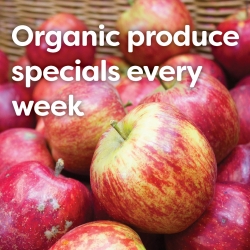
Why Buy Organic?
"...food bearing only a non-GMO label or claim is not making any other assurances about how it was produced."
When it comes to food labels, the USDA Certified Organic seal is the gold standard and indicates so much more than just “pesticide-free food.” The label represents a sustainable, transparent and ecologically sound system of food production that not only produces abundant, nutritious, delicious food but also speaks to one of today’s hottest food topics: genetically modified organisms (GMOs). GMOs have never been allowed in organic production and remain excluded from organic certification to this day.
Most people interpret the USDA Organic seal as representing what the food isn’t. Organic food isn’t contaminated by toxic pesticides, antibiotics, added hormones, or synthetic fertilizers, and it isn’t irradiated or genetically modified in a lab. Since all of these things are potentially present or true in conventionally farmed and produced foods, the best way for concerned consumers to avoid them is to look for the USDA Organic seal. But the seal also represents a much broader set of positive goals for our food system, ones that protect the land and our right to know what is in our food.
Organic Agriculture Is Sustainable
At its best, organic production uses sustainable practices that once established are relatively self-perpetuating and long-term solutions. These practices include:
Building healthy soil, naturally. This is done through composting, green manure cover crops, crop rotation and other time-honored methods. Organic farmers have no need for synthetic fertilizers that can pollute our water supply.
Using biological methods to control pests. Pest management can be achieved by maintaining native plants as habitats for pollinators and beneficial predatory insects that will prey on common pests.
Maintaining humane conditions for livestock. Plenty of fresh air and space to roam means animals are healthier and farmers don’t need to rely on daily doses of antibiotics to keep them well.
Organic Systems Are Transparent
Today, most food travels many miles and changes hands multiple times before it reaches our plate, making it hard to know how it was produced. Not so for organic. Items that bear the USDA Organic seal have a fully transparent production and delivery record known as an “audit trail” that is annually documented, inspected and evaluated by third-party organic certifying agents. It’s their job to ensure organic producers adhere to the organic standards developed and enforced by the U.S. National Organic Program.
What is more, many countries participate in equivalency programs that harmonize organic certification requirements internationally. This means that for something imported to the United States to be labeled as organic, it must have international documentation that its production adhered to the same standards or better than items bearing the USDA Organic seal. There are also international certifying agents that use the same criteria all over the world that meet or improve upon qualifying certification standards. Organic is a global movement that is only increasing in momentum.
Organic is Non-GMO
GMOs are plants or animals created through the process of genetic engineering. Under the organic standards, genetic engineering is an excluded method. Genetic engineering conflicts with the basic philosophy of organic farming which takes the approach of working with natural biological systems in order to produce healthy food.
Because GMO crops are prevalent in the United States food supply (173 million U.S. acres in 2012), organic farmers must take extra steps to ensure their organic crops are not inadvertently contaminated by GMOs. These efforts are verified by their inspector each year. Methods used include buying non-GMO seeds from reputable distributors and testing them before planting, timing their planting to prevent cross-pollination with neighboring GMO crops, preserving a “buffer zone” of uncultivated land around the perimeter of the farm, and documented cleaning of farm equipment. Certifiers accredited by the USDA conduct periodic residue testing to further verify organic food does not contain prohibited substances, including GMOs.
Certified Organic, the Gold Standard
Regardless of which USDA certified organic label (“100% organic,” “organic,” or “made with organic ingredients”) appears on the product packaging, none of the ingredients inside are allowed to contain GMOs. On the other hand, food bearing only a non-GMO label or claim is not making any other assurances about how it was produced. Only certified organic food that bears the USDA label is guaranteed to provide you with all the benefits discussed in this article. This is why the seal is known as the “gold standard” of food labels.
National Co+op Grocers (NCG), of which our co-op is a member, is a founding sponsor of National Organic Coalition which advocates for preserving strong organic standards, and a partner of the Just Label It campaign which calls for mandatory labeling of GMO foods so that consumers have the right to choose.
*Thank you to NCG for this article at: strongertogether.coop
More than 3,000 items on our shelves are certified organic. To shop organic, look for products with the seal of one of these trusted organic certifying agencies:




